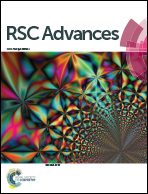Optically-transparent and electrically-conductive AgI–AgPO3–WO3 glass fibers†
Abstract
In this study, we report to our knowledge the first optically-transparent and electrically-conductive optical glass fiber belonging to the system AgI–AgPO3–WO3. The addition of tungsten oxide (WO3) into the phosphate glassy network allowed the adjustment of the glass transition temperature, thermal expansion coefficient, refractive index, optical band edge, and electrical conductivity, which are all very important parameters in view of drawing glass fibers with a desired set of electrical and optical properties. Furthermore, the addition of WO3 can improve considerably glass stability against water and humidity in the environment. AgI–AgPO3–WO3 glass fibers with 15 mol% WO3 showed 2 dB m−1 optical propagation loss from 800 to 950 nm wavelength range, and 10−3 S cm−1 electrical conductivity at 1 MHz AC frequency. Complex impedance spectra and thermal activation energies ranging from 0.15 to 0.30 eV are indicative of a dominant conductivity mechanism being ionic in nature within the range of AC frequencies from 1 Hz to 1 MHz. Fibers exhibited higher electrical conductivities than the bulk glasses. Glasses in the AgI–AgPO3–WO3 system can be used for fibers that require a set of adjustable properties pertaining to electrical conductivity, optical transparency, and environmental stability.


 Please wait while we load your content...
Please wait while we load your content...